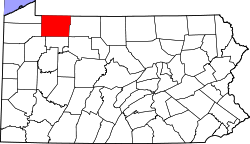Warren County, Pennsylvania | |
|---|---|
 Warren County Courthouse | |
 Location within the U.S. state of Pennsylvania | |
| Coordinates: 41°49′N79°16′W / 41.81°N 79.27°W | |
| Country | |
| State | |
| Founded | October 1, 1819 |
| Named after | Joseph Warren |
| Seat | Warren |
| Largest city | Warren |
| Area | |
• Total | 899 sq mi (2,330 km2) |
| • Land | 884 sq mi (2,290 km2) |
| • Water | 14.1 sq mi (37 km2) 1.6% |
| Population (2020) | |
• Total | 38,587 |
| 37,373 | |
| • Density | 42.3/sq mi (16.3/km2) |
| Time zone | UTC−5 (Eastern) |
| • Summer (DST) | UTC−4 (EDT) |
| Congressional district | 15th |
| Website | warrencountypa |
Warren County is a county in the Commonwealth of Pennsylvania. As of the 2020 census, the population was 38,587. [2] Its county seat is Warren. [3] The county was established in 1800 from parts of Allegheny and Lycoming counties; attached to Crawford County until 1805 and then to Venango County until Warren was formally established in 1819. [4]
Contents
- Geography
- Climate
- Adjacent counties
- National protected area
- Major highways
- Recreation
- Micropolitan Statistical Area
- Climate 2
- Demographics
- 2020 census
- Government
- Voter registration
- State Senate
- State House of Representatives
- United States House of Representatives
- United States Senate
- Education
- Public school districts
- Charter schools
- Vocational school
- Private schools
- Communities
- City
- Boroughs
- Townships
- Census-designated places
- Unincorporated communities
- Ghost towns
- Population ranking
- See also
- References
- External links
Warren County makes up the Warren, Pennsylvania micropolitan statistical area. The county is part of the North Central Pennsylvania region of the state. [a]


